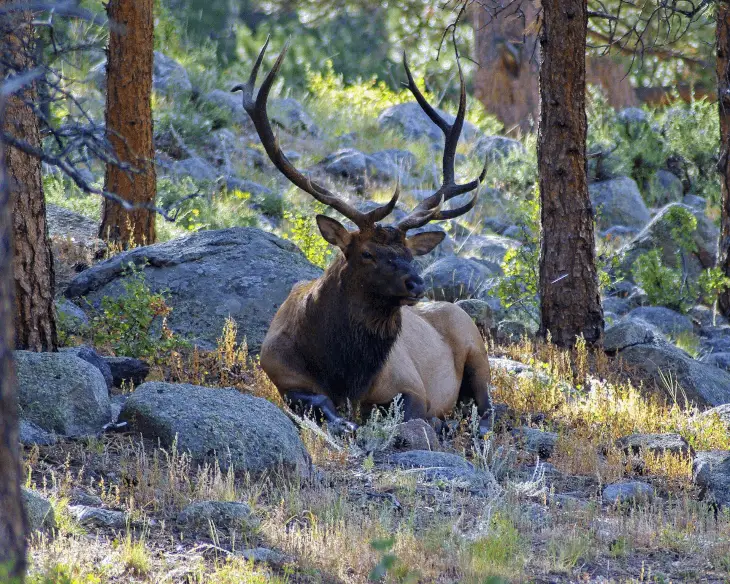If you’re a new hunter or bowhunter in North America, chances are pretty strong the first game you’ll hunt will be deer.
And, if you’re hunting deer, chances are very strong you’ll be hunting one of two kinds of deer: either mule deer or white-tailed deer. These species have a tremendously healthy population—wildlife professionals estimate that there are more than 30 million deer in the United States!—and hunting them is actually important part of maintaining our country’s animal ecosystem.
The only problem is, it can be difficult to tell one from the other. The characteristics between mule deer vs. white-tail deer can be very similar, and it’s VERY important you know what you’re hunting.
So in this post, we’ll go into detail about these two species, and provide some side-by-side examples of the differences between them. Good luck, and happy hunting!
Visual Differences
Differences between these two animals can be a little bit difficult to see, but the more you study the variations between these two animals, the clearer they become. We’ve broken the differences down in a few main categories, including:
Ear Size and Shape
This seems like a good place to start, because the mule deer gets its name from the size of its ears: they’re big and broad like a mule’s ears, hence the name.
In most cases, mule deer will have longer, pointier ears than white-tail deer. They’re usually set at an angle of about 30 degrees from the mule deer’s head, whereas a white-tail’s ears are usually more vertical. Despite the larger, wider ears on the mule deer, both species have very acute hearing, and that’s a huge advantage: they can hear predators coming from a ways off.
As you can see below, the mule deer’s ears are a lot pointier…
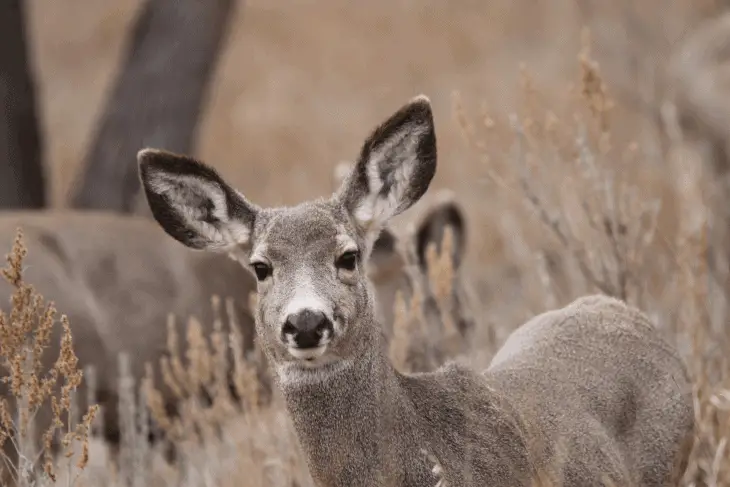
…whereas the white-tail’s ears are a lot rounder:
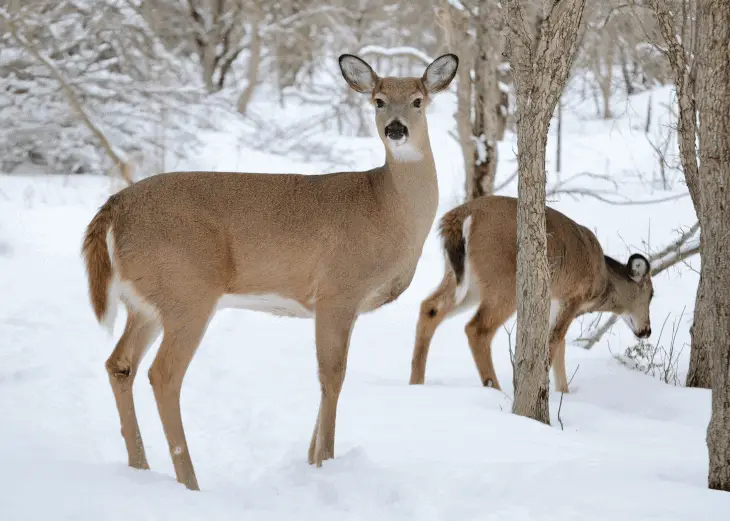
If you’re looking at these two images and thinking, “They’re not really that different,” well—there’s some truth to that! The ears aren’t really a tell-all sign, and they’re certainly difficult to see on a deer in the wild. They can look similar, and as we mentioned earlier, you’ll need to take a lot of features into account before you’ll be able to differentiate mules from white-tails.
Before we move on, here are some facts for all you Jeopardy-types out there:
- The Latin name for mule deer is “odocoileus hemionus,” which means “half-mule”; and
- The Latin name for white-tails is “odocoileus virginianus,” and that comes from the original name for white-tails, which was “Virginia deer.”
Now you know!
Tail Size and Color
Keeping on the topic of names, the white-tail gets its name because… yep, you guessed it! Its tail is white.
What makes things confusing—and what makes the names a little misleading—is that the mule deer also has a white tail.
Here’s the difference between the two:
A white-tail uses its white tail as a signal: when they’re in danger, their white tails will dart up as a signal to other deer that there’s trouble someplace near. Mule deer don’t do that—they have the white tail, but it’s not used to communicate in the same way.
There’s another difference, too, though: mule deer tails are a little thinner—they kind of look like a rope—and they have black coloring around the edge of the tail, as you can see here:
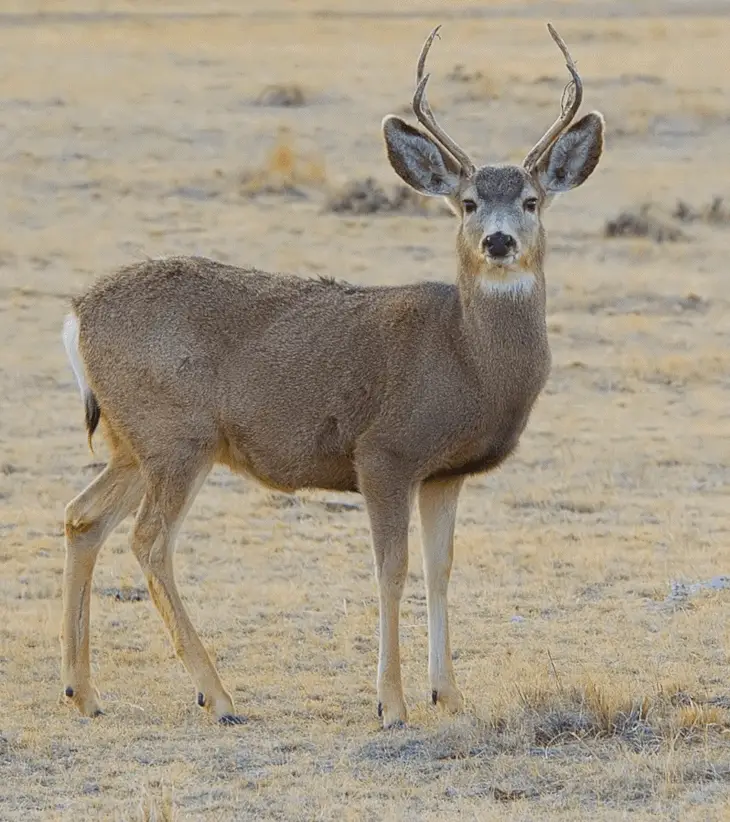
(Photo Credit: Yathin SK, via Creative Commons Attribution-Share Alike 3.0 Unported license)
Notice above the black-ish coloring at the end of the mule tail—that’s a very strong indicator that the deer is a mule. If you look at the white-tail below, there’s no darker coloring at the end of the tail:
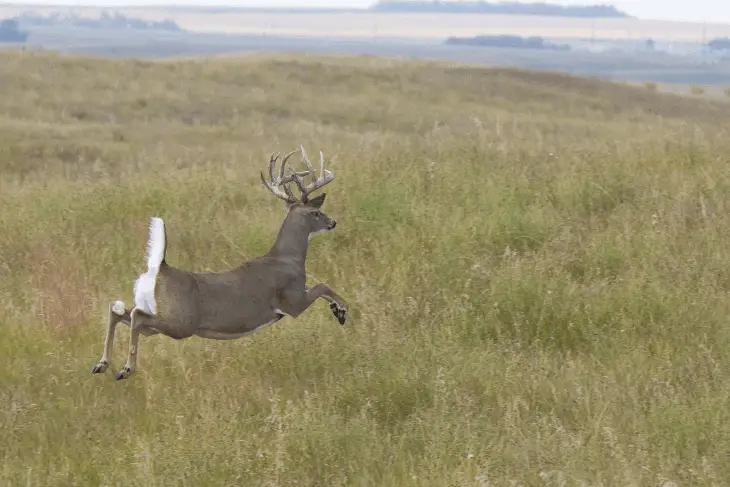
Also notice that the tail on that white-tail deer is REALLY showy and obvious. As we mentioned, that’s so other deer can see it and be on high alert, but it’s also to send a message to any predators in the area—basically saying, “I’m aware of you and that you want to eat me, and I’m going to run and make you spend a lot of energy chasing me, so it’s better to just let me go.”
One more tail-related item before we move on: there’s a kind of deer called the black-tailed deer, and that’s actually a sub-species of the mule deer, and it shares a LOT of traits of the mule deer. We talk about black-tailed deer in this post here.
Antler Growth and Formation
This next difference you’ll only see on bucks: antler formation.
Most mule deer have antlers that “fork”—that is, they divide in two, and then each of those forks divide in two. It doesn’t always work like that—there’s a lot of variation in nature, thank goodness—but that pattern is what you’ll usually see on a mule deer.
White-tail deer, however, have an entirely different growth pattern to their antlers. They have a single main beam, and tines grow out from that single beam. The result is two very different-looking sets of antlers.
Here you see the mule deer’s antlers forking in two:
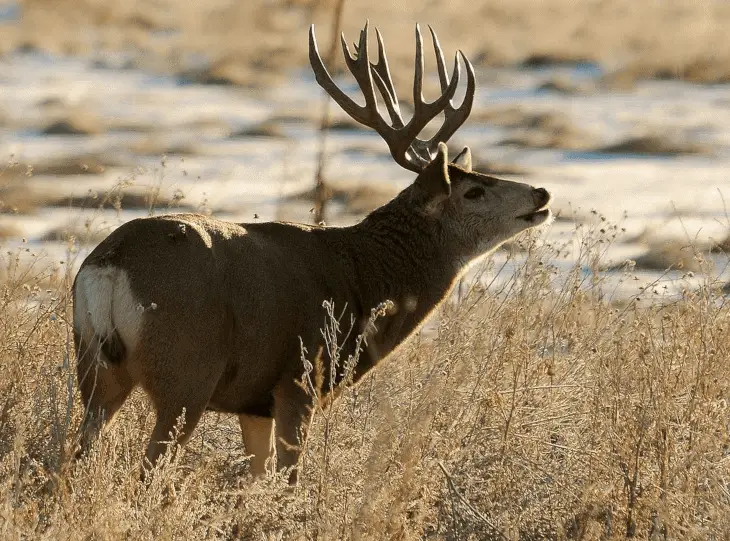
(Photo Credit: Rich Keen / DPRA, via Creative Commons Attribution 2.0 Generic license; image re-sized, no other changes made).
…whereas here you see the whitetail deer with a single beam, and the tines spiking upwards along that beam:
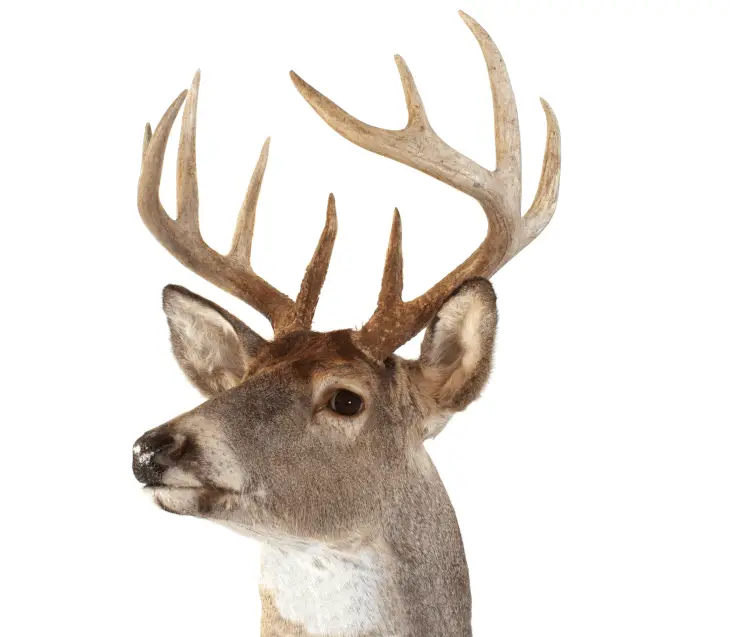
Again, we chose these examples because they’re easy to see—very often in nature, antler formation will be a little tricky to discern.
Before we move on, there are two other things we should mention about antlers:
1) The racks on mature mule deer will usually be broader and taller than on mature white-tails; and
2) Both mules and white-tails shed their antlers every year, with white-tails doing so in January or February, and mules doing so in February or March.
Facial Differences
Mule deer typically have more white and white tones on their faces than white-tails do, and it’s usually a lighter color than the rest of their oat. They tend to have darker foreheads than white-tails, as well. White-tails usually have brown-ish tints on their faces, with white-ish rings around their nose and eyes.
Here’s a mule deer with a lot of white on its face:
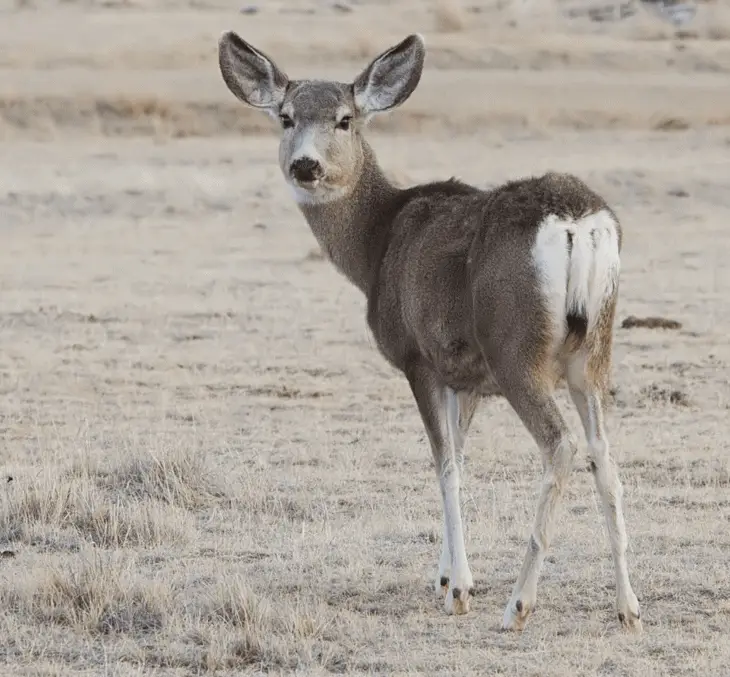
(Photo Credit: Yathin SK, via Creative Commons Attribution-Share Alike 3.0 Unported license)
…and here’s a white-tail deer, and you’ll notice that there’s almost no white from the nose to the eyes:
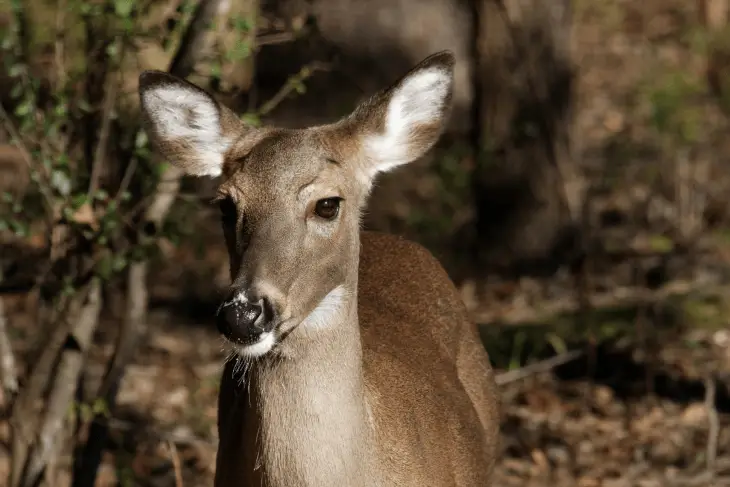
There may be a little bit of white behind the white-tail’s nose, but very little on the bridge to the eyes.
Both species have a patch of white in the throat area.
Coat Colors
Next up in our mule deer vs. white-tail deer study: coat color.
There’s a great degree of variance within the mule deer population and the white-tail deer population, but as a general rule of thumb…
Mule deer have a grey-ish/brown coat—similar to a color you’d see on an open plain. White-tail coats are something of a reddish/brown color, and can even appear orange-ish.
Here are three mule deer, and note the brown-ish color of the coats:
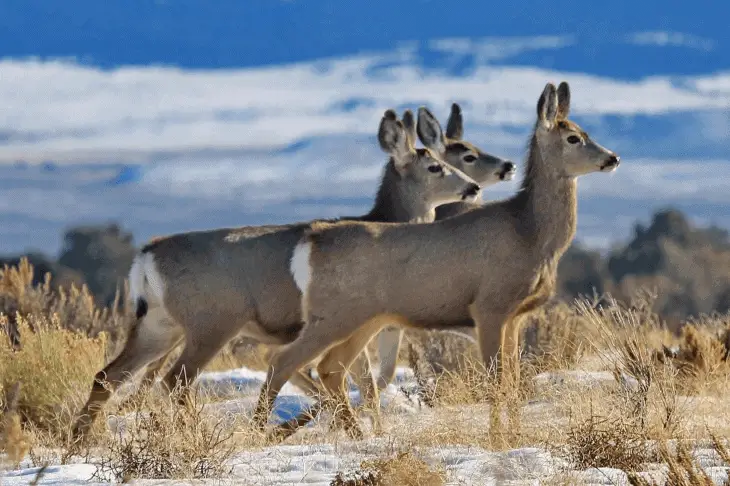
…and compare that to the reddish hue of the whitetails below:
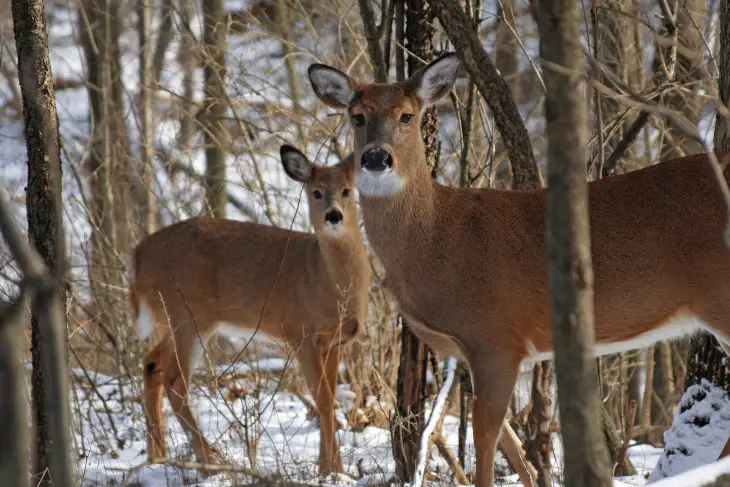
Coat color is another tricky distinguisher, because there’s some overlap in coat color, but also because white-tails’ coats tend to get a little more grey during the winter. As with all these characteristics, you need to take all the other characteristics into account.
Overall Shape and Size
There are a LOT of factors that go into body size, and it’s usually a combination of genetics, nutrition, age, and environmental factors (among many others!), but all things being equal the average mule deer will probably be just a bit bigger than the average white-tail. They can weigh anywhere from 75 pounds (on the very low side) to 350+ pounds (on the very high side). Both are usually anywhere from 36 inches to 42 inches at the shoulder.
Deer of both varieties seem to follow Bergmann’s Rule, which states that the animals in colder, more northern regions tend to be larger than the animals found in warmer, more southern regions. In North America, the further north you head, the larger you’ll see both species.
Mule Deer vs. White-Tail Deer: Behavioral Differences
So now that you have a pretty good idea of the physical differences between white-tails and mules, let’s take a look at some of the other differentiating factors between these two types of deer—and how they’ll make a difference in your hunt.
The first difference is the biggest difference on this list:
Location, Location, Location
If you’re in any of the states that border the Atlantic Ocean, differentiating these two species just got a whole lot easier: there are no mule deer on the East Coast. If you’re hunting anywhere from Florida to Maine, the deer you’re looking at is almost certainly a white-tail. There are very few, if any, mule deer on the East Coast.
Mule deer are usually located west of the Missouri River, with plenty of them around the Rocky Mountains and the West Coast, all the way from Mexico all the way up into Canada.
Here’s where it gets tricky: white-tails expand pretty far west, as well, and if you’re located west of the Missouri River, you’ll need to be able to differentiate between the two. There are parts of Nevada and California that don’t have any white-tails, but pretty much every other state has white-tails.
Reproductive Differences
There are slight variations in reproductive schedules between these two types of animals, and here’s how it breaks down.
Mule deer:
- Mate mid-November to late November;
- Have a gestation period of seven months; and
- Does need be older than six months to breed.
White-tails:
- Mate late in November to early December;
- Take only 6 1/2 months to gestate; and
- Does can breed at only six months of age.
White-tails have a biological advantage here (and a higher birth rate), because they’re able to breed earlier in the life cycle, and the gestation period is around two weeks shorter.
Does of both species usually deliver a single fawn the first time she gives birth, and then after that, will usually produce two deer at the end of a gestation cycle (although some does can birth up to four fawns), and fawns are usually born in late May / early June.
Predatorial Differences
Both species share a “usual suspects” list of predators, and that list includes wolves, coyotes, and cougars (and, of course, humans). Most predators attack either old or young, and if a doe or buck has made it to maturity, their chances of survival from these predators is higher.
Movement and Aggression
So let’s talk behavior: how do these two species move? What are they like?
The biggest difference is their composure. White-tail deer are a LOT more jittery than mule deer, and they spook very easily (there’s a classic “West-Coast-folks-are-more-laid-back” joke we could make here, but we’ll skip it for now). If you surprise a white-tail with noise or sudden movement, chances are very strong they’ll shoot that tail up and bound away.
If you’re hunting whitetails, you need to be very aware of your scent, but you need to be VERY aware of the sounds you make. There’s a reason why so many hunters like tree stands and ground blinds when hunting white-tails, and that’s because they provide a really silent method of attack.
Mule deer are a lot more tolerant of noise and commotion. Not that they’re immobile—they’re certainly not—but they can seem to accept a little more agitation before darting off. If you’re going after mule deer, you should also mind your scent and your sound, but you may have more opportunities when it comes to spot-and-stalk hunting.
The other big difference between these two is their method of locomotion. Mule deer have a sort of “hop” that they use to escape from predators, whereas white-tails have more of a gallop. There are a few videos on YouTube that show the difference in form, and here are the two we think are the best.
Here’s the mule deer bouncing and hopping away:
And here’s the white-tail running / galloping:
…and there you have it! Now you know the most striking differences between these two species, and how to tell them apart.
We’ve Found That a Lot of the People…
…who are interested in the differences between mule deer and white-tail deer are new hunters and bowhunters. If that’s you, we invite you to look around. We’ve got a lot of content for new hunters, including a big list of safety tips, guidance on how to get your first hunting license, and some of the terms you’ll hear again and again as you learn more about bowhunting. We hope they help!
That about wraps it up for this post. Thanks for reading, and all the best to you!



